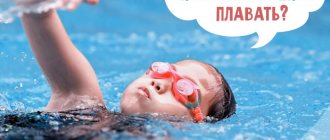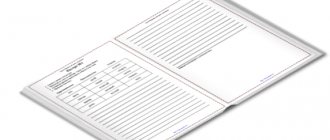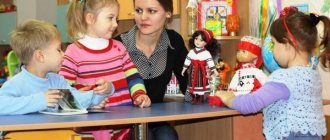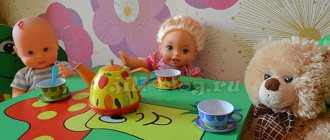Program for organizing swimming in the pool in a kindergarten
Tatyana Shelyashkova
Program for organizing swimming in the pool in a kindergarten
Explanatory note
Focus of the work program : Physical education and sports - a program focused on organizing swimming in the pool in a kindergarten . The program is implemented during the educational process. In accordance with SanPiN standards and the distribution of the teaching load for each age group. The pedagogical feasibility of this educational program is due to the fact that swimming promotes comprehensive physical development, stimulates the activity of the nervous, cardiovascular, respiratory systems, and significantly expands the capabilities of the musculoskeletal system. With the help of applied swimming , we develop important skills for a person, such as saving one’s own or someone else’s life, which has a positive effect on the child’s personal qualities.
Program mastery level
Water level of the program : Designed for children in their first year of education from 1.5 years old. At this level of learning, children must adapt to water. Learn to independently get into the water and move around the entire area of the pool . Getting used to water is designed for children from 1.8 to 7 years old.
The basic level program for children must learn to swim in all ways without the use of support devices is designed for children from 3 to 7 years old
Advanced level of the program teaching children to swim in all ways , access to deep water (inter-district/city sports festival Dolphin)
, passing selections for Olympic reserve schools.
Relevance of this program .
This program is developed on the basis of the Simultaneous methodology for teaching swimming to preschool children and primary schoolchildren. The uniqueness of this program is that preschool No. 272 works using an inclusive education system, and elements of a simultaneous teaching method allow children with disabilities to get a good emotional mood and be in a situation of success. Systematic swimming have a beneficial effect on the level of swimming readiness indicators. Teaching swimming to preschool children is an implementation of the state program of mass swimming training , which promotes health improvement and full physical development. Swimming is a natural form of physical exercise, an excellent means for developing and improving the physical qualities of a preschool child, carrying out correctional work, and has a significant impact on his health. This is one of the most effective forms of hardening and prevention of many diseases. Applied swimming are of great educational importance. They create conditions for the formation of personality. They also introduce children to swimming and other sports. One of the most important values of mass swimming for preschool children is the guarantee of safety on the water, conscious safe behavior, and therefore a reduction in accidents, because a large percentage of those who die on the water are children.
The skills and abilities that preschool children will receive during lessons in the pool will help save their own and others’ lives, develop their lungs and improve their health for choral or chamber singing, and will enable the child to fully use their abilities in any area of life from sports to government leadership.
Pedagogical expediency is due to the fact that as the program , the tasks of forming are solved:
• swimming ;
• take care of your health;
• personal hygiene skills;
• ability to control your body.
Successful solution of the assigned tasks is possible only with the integrated use of all means of physical education.
The forms and methods of organizing proposed in this contribute to the creation of a situation of success, which allows children to receive positive emotions in each lesson from achieving the goals set in the lesson. As a result of systematic swimming , the strength and mobility of nervous processes in the cerebral cortex increases, the plasticity of the nervous system increases, which makes children more balanced, better controls their behavior and quickly adapts to new types of activities in different environments.
Distinctive features. The combination of methods and forms of conducting classes makes it possible to achieve high levels of mastery of the program . This program is based on the method of simultaneously teaching children to swim , which provides variability in movements and mastering swimming skills for children with disabilities. In parallel, the consistent development of methods that are similar in structure, starting with the development of leg movements and without taking into account the individual characteristics of development (traditional)
N. Zh. Bulgakova, 1999; T. I. Osokina, 1985. Simultaneous
(T. A. Protchenko, 1990, which forms the basis of “Training” program
swimming for children from 2 to 7 years old " (T. A. Protchenko, 2007, 2013)
.
Goal and tasks:
Goal: teaching preschool children swimming , hardening and strengthening the child’s body , ensuring comprehensive physical development. And carrying out corrective work. As well as gaining knowledge of safety precautions on reservoirs, skills and abilities of applied swimming .
To achieve this goal, the following tasks are formed:
Educational:
• mastering sports swimming , studying the technique of front crawl, backstroke, breaststroke, dolphin. Mastering applied swimming : Towing a victim or things, falling into the water with clothes on and even with a backpack on your back.
• introduce and formulate the theoretical and practical foundations for the development of water space;
• provide material on the history of sports and knowledge of various water sports.
• introduce children to the basic rules of safe behavior on water (in open water, in a swimming pool )
.
• introduce and teach children sports and non-sports methods of swimming .
Educational:
• develop motor activity
• develop coordination of movements
• develop and improve the respiratory and cardiovascular systems.
Educators:
• interest in sports and love for physical education.
• foster independence and organization
• cultivate moral and volitional qualities
The age of children participating in the implementation of this program is 1.5-7 years.
The preschool educational institution carries out targeted, comprehensive work to teach children swimming , which includes the following forms:
— directly educational activities in swimming ;
— health and preventive complex hardening procedures
— entertainment, holidays on the water.
categories of students.
Forms of organization of educational activities and mode of operation The leading form of organization of training is group. Along with the group form of work, the learning process is individualized and a differentiated approach to children is used, since due to their individual characteristics, the effectiveness in mastering swimming may be different. For children with disabilities, a group form and an individual one are used. Classes are held 2 times a week in all age groups. Individual lessons are provided. Forms and mode of classes. The organization of teaching children swimming in kindergarten is carried out in conjunction with all the diverse forms of physical education and health work. The total number of swimming lessons is 72 .
A walk for children after swimming in the pool is organized no less than 50 minutes later, in order to prevent children from hypothermia. (San Pin clause 12.7)
.
The leading form of organization of training is subgroup. Taking into account the individual characteristics of children, individual additional classes are also conducted with the setting of tasks taking into account the capabilities and abilities of the pupil. The presence of a swimming pool in a kindergarten all children , starting from a young age, in educational swimming activities Teaching children to swim is a series of interrelated processes that are quite complex in organizational and methodological terms. Only in combination with direct educational activities in the pool with the regime of activity and rest for children can a positive result be obtained in promoting health and strengthening the body .
Planned (expected)
results of mastering
the program
Children must learn:
• basic rules for safe behavior on the water;
• rules of personal hygiene;
• basics of a healthy lifestyle.
Children should have an idea:
— about different methods of swimming ( “crawl”
,
"breaststroke"
,
"dolphin"
)
- about water sports.
A way to determine the effectiveness of the implementation of this program is internal testing of swimming , which is carried out 2 times a year (September, October, March, April)
in the form of control exercises.
The forms for summing up the implementation of this program are :
• internal skills testing
• open classes for parents in each age group;
• sports entertainment and holidays on the water;
• swimming “Dolphin”
PROGRAM CONTENT
swimming skills .
Skill Characteristic
Diving underwater with your head Helps get rid of the fear of water
Opening your eyes underwater Helps you coordinate your movements underwater without fear
Diving Helps you gain a sense of confidence, teaches you to regulate the volume of inhalation and exhalation.
Falling into the water One of the elements of applied swimming . Helps to develop the skill of saving one’s life when falling into water from any position
Lying down Allows you to feel the statistical lifting force, keep the body in a state of balance, and teaches you to overcome the feeling of fear.
Sliding Allows you to feel the lifting force of the water, teaches you to move and navigate in the water, work alternately with your arms and legs, swim long distances, improves other skills, and helps develop endurance.
Controlled breathing Rhythmic correct breathing, coordinated with the rhythm of movements, teaches you to overcome water pressure, develops the respiratory muscles, it is closely interconnected with all skills.
Step-by-step formation of swimming
Stage I
Result (tasks)
Age of children ( relatively )
Stage of accustoming to water. Introduction to water and its properties (wet, transparent)
.
Get into the water yourself. Move across the entire area of the pool with or without assistance . Mastering with water and the simplest games “bring a toy” “Throw Ani’s ball”
Early and early preschool age.
Stage II
Result (tasks)
Age of children ( relatively )
Children acquire skills and abilities that help them feel secure enough in the water (float, lie down, slide, independently inhale and exhale into the water). Be able to hide under water, fall without support, by the end of the year. Work with your hands as when swimming with Brass or Dolphin. Junior and middle preschool age.
Stage III
Result (tasks)
Age of children ( relatively )
Learning to swim in certain methods of sports swimming (coordination of movements of arms, legs, breathing)
. Senior preschool age.
Stage IV
Result (tasks)
Age of children ( relatively )
Continuing to master and improve the technique of swimming and simple turns. Senior preschool and junior school age.
BIBLIOGRAPHY
1. Voronova E.K. Swimming training program in kindergarten . — SPb.: “ CHILDHOOD-PRESS ”
, 2003.-80 p.
2. Health complex in kindergarten : swimming pool - herbal bar - sauna : Methodological manual / Team of authors, ed. B. B. Egorova. - M.: Publishing house "GNOM and D"
, 2004.- 160 p.
3. Osokina T.I. How to teach children to swim : A manual for children's educators. garden - M .: Education, 1985.-80 p.
4. Osokina T.I. et al. Teaching swimming in kindergarten : Book. for a kindergarten teacher garden and parents - M .: Education, 1991.-159 p.
5. Programs for initial swimming training / Ed . S. I. Ezhikova - Moscow, 1983. - 70 p.
6. Lawrence D. M. Aqua aerobics. Exercises in water. M; 2000.
7. Yakovleva S. A. Games and teaching swimming to younger preschoolers. // Physical education instructor. – 2009. – p. 96.
8. Rokosovskaya L.G. Training in breaststroke swimming . // Physical education instructor. – 2009. – p. 55.
9. Askarova G. N. The use of non-standard equipment in teaching preschoolers swimming . // Physical education instructor. – 2009. – p. 38.
10. Esipova S. N. Interaction between preschool educational institutions and families in teaching children swimming . // Physical education instructor. – 2009. – p. 94.
11. Polunina N. S. Teaching children water dancing with elements of synchronized swimming . // Physical education instructor. – 2010. – p. 98.
12. Yablonskaya S.V., Tsiklis S.A. Physical education and swimming in kindergarten . – M., 2008.
Literature for parents.
1. Firsov Z.P. Swimming for everyone . – M., 1983.
2. Bulgakova N. Zh. Teach children to swim . – M., 1977.
3. Levin G. Swimming for kids . – M., 1974.
4. Gorbunov V.V. Water gives health. – M., 1990.
5. Litvinov A. A., Ivanchin E. V. The ABCs of swimming . – St. Petersburg. 1995.




